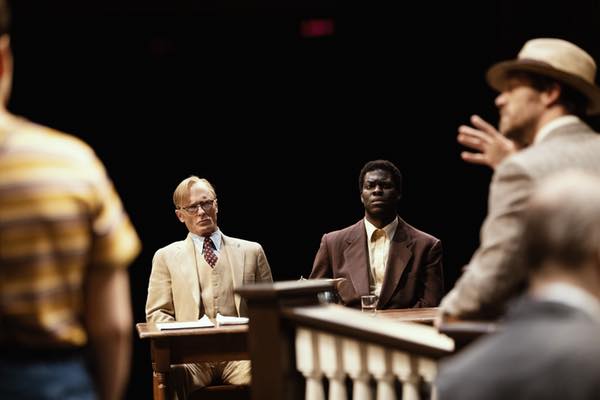
Not all novels — in fact, most novels — do not lend themselves to being turned into plays. While To Kill a Mockingbird, directed by Bartlett Sher and now at Playhouse Square’s Connor Palace, succeeds in dramatizing novelist Harper Lee’s strong message, it tangles its metaphorical feet walking the adaptation tightrope. (By contrast, Horton Foote’s film version starring Gregory Peck deserves its classic status.)
That is not to say that the drama, part of Playhouse Square’s Broadway Series, is a failure. It is not. Screenwriter Aaron Sorkin, faced with adapting Lee’s nuanced, but memoirish, fiction about growing up in Alabama in the 1930s, crafts a patchwork-quilt storyline. The resulting drama touches on the big topics: loss of innocence, racial justice, personal integrity, civic duty, the dangers of kindness, of pride, the legal system, and mob violence. That’s a lot to weave into a single two-plus-hour play. (Ask Shakespeare.)
Six-year-old Scout, her ten-year-old brother, and their friend Dill roam freely around their small Alabama town, talking to everyone they meet (except the scary Boo Radley) and sneaking in the courtroom to watch a trial. The story is supposed to be from their point of view, but since Scout’s memories are overlaid by the adult Scout’s viewpoint, it doesn’t always work as well as it does in the novel, a place where the storytelling voice creates a unity, a mood.
Richard Thomas, as lawyer Atticus Finch, convincingly plays Scout’s loving father. (Yes, John-Boy Walton has grown up and he turned out fine.) The play’s key scene is the trial of Tom Robinson, a Black man falsely accused of assaulting a white woman. Here Finch’s stirring courtroom speech evokes Sorkin’s righteous characters in West Wing. Unfortunately for Tom Robinson (Yaegel T. Welch), the trial’s result also reveals Finch’s weakness, his pride.
Welch’s touching portrayal of Robinson shows his character’s honesty (and his courtesy — little good that does Robinson). Young Scout, now watching from the courtroom’s balcony (perched like a little bird), sees how combustible and flawed her beloved community can be.
Melanie Moore plays Scout Finch dressed as a child and is convincing as her persona switches from adult to child. (That said, I think the Cleveland-set A Christmas Story handles it better with one actor playing the child and another the adult observer.)
Jacqueline Williams, the Finch family’s Black cook Calpurnia, shows she’s the glue that holds the Finch family together. When she disapproves, her face and posture reflect her opinion better than any words might convey.
Justin Mark plays Scout’s brother Jem Finch and Steven Lee Johnson appears as their best friend Dill Harris. In the life’s irony department, the Finch family’s cranky neighbor, Mrs. Dubose, is played by Mary Badham, the actress who played Scout in the film.
Joey Collins plays the villainous Bob Ewell and Arianna Gayle Stucki portrays his mentally disabled daughter Mayella. Near cartoonish, certainly stereotypical, Sorkin’s Ewells are people we can safely despise. The mysterious Boo Radley (Travis Johns) appears briefly, but you’d have to read the novel to understand his importance and his sudden inclusion in the last part of the last act.
Scenic designer Miriam Buether crafted the ingenious and shifting setting (powered by actors who must do a bit of weight training). Other credit goes to Ann Roth (costumes), Jennifer Tipton (lighting), and Scott Lehrer (sound). Brief and welcome musical notes came from an original score by Adam Guettel.
Bottom Line: Those few who have not read Harper Lee’s To Kill a Mockingbird might get lost. Those who have should be able to work their way through this moving story (and yes, it made me cry) peopled by appealing (and not so appealing) characters. It’s also quite long.
[Written by Laura Kennelly]